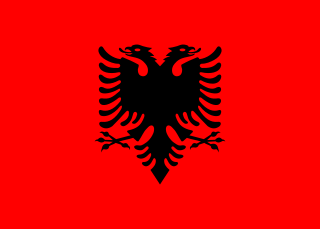
Albania, officially the Republic of Albania, is a country in Southeast Europe. It is in the Balkans, on the Adriatic and Ionian Seas within the Mediterranean Sea, and shares land borders with Montenegro to the northwest, Kosovo to the northeast, North Macedonia to the east and Greece to the south. With an area of 28,748 km2 (11,100 sq mi), it has a varied range of climatic, geological, hydrological and morphological conditions. Albania's landscapes range from rugged snow-capped mountains in the Albanian Alps and the Korab, Skanderbeg, Pindus and Ceraunian Mountains, to fertile lowland plains extending from the Adriatic and Ionian seacoasts. Tirana is the capital and largest city in the country, followed by Durrës, Vlorë, and Shkodër.
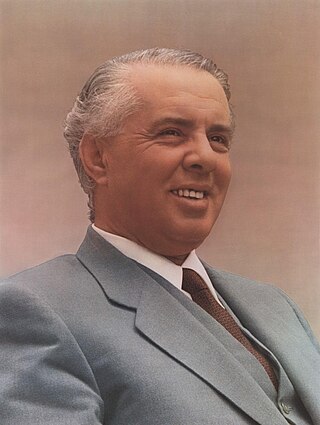
Enver Hoxha was an Albanian communist politician who was the ruler of Albania from 1944 until his death in 1985. He was the First Secretary of the Party of Labour of Albania from 1941 until his death, a member of its Politburo, chairman of the Democratic Front of Albania, and commander-in-chief of the Albanian People's Army. He was the twenty-second prime minister of Albania from 1944 to 1954 and at various times was both foreign minister and defence minister of the country.

Tirana is the capital and largest city of Albania. It is located in the centre of the country, enclosed by mountains and hills, with Dajti rising to the east and a slight valley to the northwest overlooking the Adriatic Sea in the distance. It is among the wettest and sunniest cities in Europe, with 2,544 hours of sun per year.

Butrint was an ancient Greek polis and later Roman city and the seat of an early Christian bishopric in Epirus.

Lezhë is a city in the Republic of Albania and seat of Lezhë County and Lezhë Municipality. It is one of Albania's continuously inhabited cities, with roughly 2,400 years of recorded history.
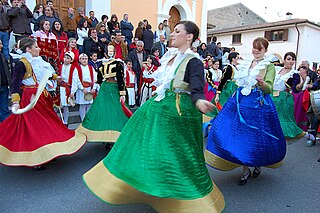
Albanology, also known as Albanian studies, is an interdisciplinary branch of the humanities that addresses the language, costume, literature, art, culture and history of Albanians. Within the studies the scientific methods of literature, linguistics, archeology, history and culture are used. However the Albanian language is the main point of research of the studies.

Neritan Ceka is an Albanian archaeologist, professor, and politician. He served as Albania's Minister of Internal Affairs from 27 July 1997 to 18 April 1998.

The Academy of Sciences of Albania, founded in 1972, is the most important scientific institution in Albania. In the 1980s, several research institutes began at the University of Tirana were transferred to the Academy's jurisdiction. The institution includes the most distinguished scientists, also called "academics", that are involved in research centers and other organisations inside and outside Albania. As of 2009, the Academy had 23 regular members, 10 associated members, one permanent member, and 26 honor members.

Studime Historike is a scientific magazine on albanology. It is published by the Institute of History, part of the Centre of Albanological Studies in Tirana, Albania.
It is profilised as a bulletin short studies or articles dealing with Albanian history, from antiquity to nowadays. Beside historical thematic, it publishes studies presented in scientific events as conferences and symposiums, archival documents, pieces of historical memoirs and materials, information of scientific activities organised by the Institute of History, etc.
It provides information of latest publications of the Albanian Institute of History, both Albanian and foreign albanologists.
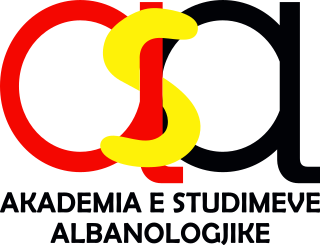
The Academy of Albanological Studies (AAS) is the main institution of albanology in Albania.
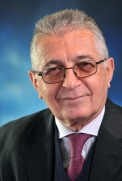
Jorgo Bulo was an Albanian philologist, historian, and literary critic. Since 2003 up to his death (2015) he was a member of the Albanian Academy of Arts and Sciences.

The Mother Teresa Square is the second largest square in Tirana, Albania. It is named after the Albanian-born Indian Roman Catholic nun, missionary and Nobel Peace Prize laureate Mother Teresa.
Prehistoric Albania, compared to the other regions of the Mediterranean Europe, was relatively lately inhabited by Homo sapiens. The earliest known human settlement dates back to the Upper Paleolithic, 40,000 BC in the Kryegjata Valley, near the antique site of Apollonia. Several further Paleolithic sites have been excavated, out of which the most prominent ones are the cave of Konispol, the flint tools found near Xarrë, the shelters of the Blaz Cave near Urakë and the habitation of Mount Dajt, then during the period of the Mesolithic the aforementioned Kryegjata, Konispol and Gajtan sites represent more developed stone, flint and horn tools. Another important site of the Mesolithic industrial activity is the flint mine of Goranxi that was in operation around 7,000 BC.
Illyrology or Illyrian studies is interdisciplinary academic field which focuses on scientific study of Illyria and Illyrians as a regional and thematic branch of the larger disciplines of ancient history and archaeology. A practitioner of the discipline is called Illyrologist. His duty is to investigate the range of ancient Illyrian history, culture, art, language, heraldry, numizmatic, mythology, economics, ethics, etc. from c. 1000 BC up to the end of Roman rule around the 5th century.

The Archaeological Museum of Butrint was opened in 1938. It was reopened during the 1950s-1960s in the premises of the Venetian Acropolis Castle within the acropolis of the ancient city. It containes the Graeco-Roman archaeological finds from the Italian Archaeological Mission of the period between the two World Wars, led by Luigi Maria Ugolini.
Shpresa Gjongecaj Vangjeli is an Albanian archaeologist and numismatist, who was the Director of the Institute of Archaeology at the Academy of Albanological Studies from 2008 to 2013. She is the recipient of the Vermeil Token from the French Numismatic Society and was appointed a Corresponding Member of the Archaeological Institute of America, both in recognition of her scholarship and services to numismatics.

Illyrian education is a term in the field of the history of education and pedagogical thought that denotes the totality of forms, organizations and educational institutions in the Illyria and among Illyrians. In the early periods, the education in Illyria and among the Illyrians was under the influence of Greek education, while later it was under the influence of Roman culture. Based on the latest scientific research and discoveries in various aspects of Illyrology: historical, archeological, epigraphic, linguistic, paleographic, etc., it has become possible to better summarize the Illyrian educational system. Illyrian education stretches over a period of time between the 8th century BCE, when the Illyrian culture began to flourish, and the 7th century CE, when the Illyrians are last mentioned in historical sources. In general, it can be said that education among the Illyrians was developed starting from a level of family and informal education towards an organized, institutional, and formal educational system.
Selim Islami was an Albanian archaeologist and historian from Sarandë who contributed to the development of Illyrian studies.
Skënder Anamali was one of the founders of Albanian archaeology. He made significant contributions to the field of Illyrian studies.
Aleksandra Mano was an Albanian archaeologist who made significant contributions to the study of Illyrian archaeology.














